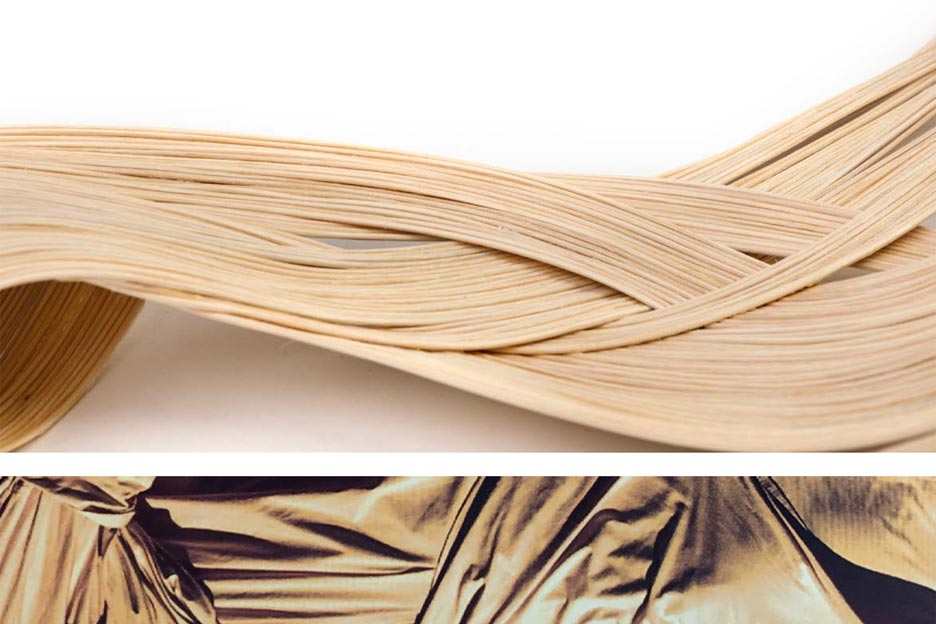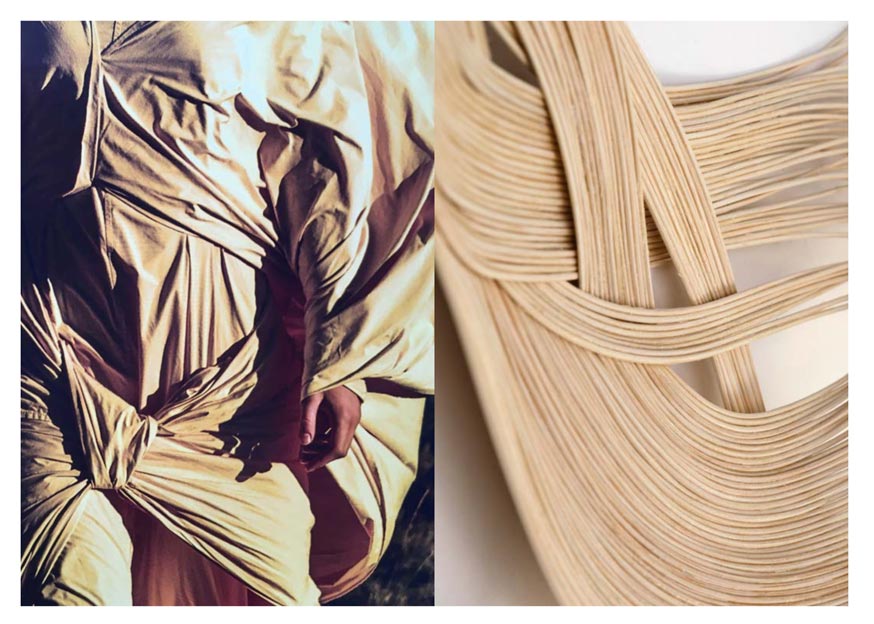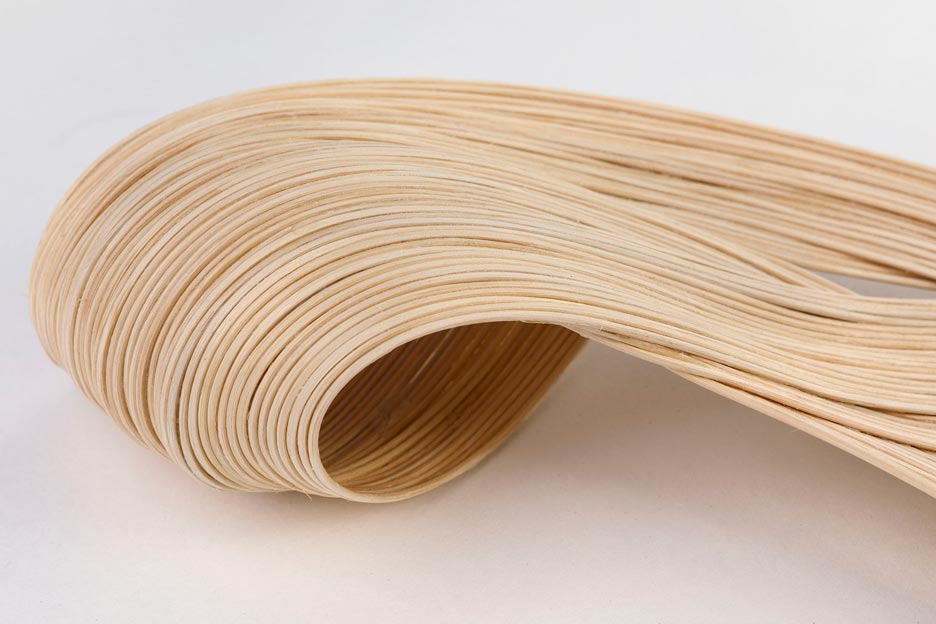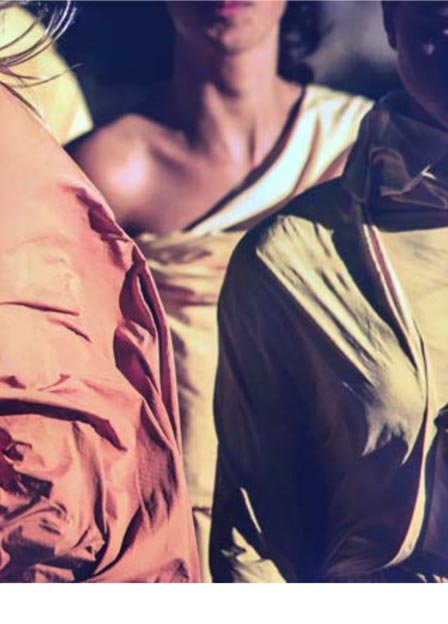WILD FIBERS Daybed
2019
Unique
Rattan
The rattan material used for the Wild Fibers Collection is collected in the Indonesian jungle respecting a natural cycle of growth that do not affect the middle and is not from deforestation. This rattan is a completly ecological natural fibres guaranted with no chemical treatment during the processing.
WILD FIBERS Collection
World premiere of the Wild Fibers Collection by Li Edelkoort & Philip Fimmano in La Manufacture: a labour of love, exhibition’s presented during Lille Design World Capital 2020. The Wild Fibers Duchess, which was directly acquired by the Centre Pompidou, National museum of modern Art of Paris, for the Design permanent collection.
Rattan as an architecture of the body in movement…
Elegant, flexible, versatile, gentle to the touch yet hard and resistant are just some of the natural features of this incredible material. Growing amongst the plants and animals of the tropical rainforest, rattan boasts itself as the longest fibre in the world. Aurélie Hoegy rediscovered this magnificent material upon visiting Indonesia, thus enabling her to launch a special design project. Whilst first tracing inspiration from the human body in The Dancers in 2016, she now explored the innate liveliness of material itself.
Used in crafts since the dawn of time, rattan has been connected to many styles. Yet one can observe that the qualitative and creative potential of the fibre’s organic shapes have been relatively constricted through the semi-industrialisation and mass production of its final products. Traditional and practical norms have also played a role in limiting its natural form.
Hoegy’s primary focus therefore consisted of drawing upon the material in its essence, along with the idea of forming a symbiosis between bodily movement and the dynamic quality of the fibre. Her object would thus be considered both as a moving body and as a living material, shifting the boundaries from the inert to the living.
“The work of the craftsman implies collaboration with his material. Instead of imposing a preconceived idea or shape, he needs to listen to his material.” Juhani Pallasmaa
Taking a residency in Bali gave the artist and designer a most advantageous position, to not only explore the roots and origin of the craft, but also to assimilate the techniques in real time, deepening her sensory knowledge and diving into experimenting with the fibre. Over a one-month stay, she worked in close collaboration with skilful Balinese craftsmen in a traditional workshop, completing a full-scale prototype. This first tentative piece started with the classical chair frame. From the legs up, the fibre moulds itself to the skeletal structure, but as one progresses upwards, the movement unfolds. The stems begin to unbridle themselves and branch out more naturally.
Upon returning to her Paris studio, Hoegy started to further develop the concept and focused on creating an extensive “library of form” while immersing herself further into the craft. Additionally she developed a final assembly line starting from traditional techniques and evolving them into the specifics necessary for the final output of this new collection.
Rattan fibres need to pass many stages of processing before they are ready to use. After harvest, the spiny leaf sheaths are removed on the spot. Rattan that is small in diameter is then subjected to a process called runti or lunti in Indonesian, which means removing the siliceous epidermis by various methods; rubbing, fumigation, oil curing, bleaching, washing, polishing… These treatments are necessary to avoid defects and to increase processing possibilities and the market value.
Following a path of experimentation and listening to the fibre, Hoegy is able to make pieces whose movement marries the traditional structure of the chairs while keeping the rattan’s own organic forms. This gives a natural and fluid anchorage to the furniture. Within the changing context of an increasingly virtual and disconnected society, Hoegy believes we need to reconnect with materials. Design can become a powerful rebalancing tool through archetypical objects; creating a collaborative symbiosis between the object.
“ People know they need to slow down the pace of overconsumption and overproduction; otherwise our planet will be lost. The creative world gains insight and invents systems where values shift and design plays an activist role, developing ideas about sharing between designer and the worker, designer and the underprivileged, designer and the amateur, designer and the designer… This new era gives hope for other ways of perceiving what is considered success, renown and profit. Here, capital is strictly human.
This social consciousness coincides with an important movement in philosophy, where each material is believed to be alive and able to emanate currents of energy, deserving the right to exist as in human rights and animal rights. The manufacturing of found, recycled and reinvented materials is testimony to this theory. The urge for matter is such that all focus is given to that particular part of the creative process, often imposing form instead of following it, since materials seem to become a living emotional element, communicating in an autonomous way, talking through tactility and attracting through energy. The open source sharing of knowledge and innovative manufacturing will become the key to a society taking care of both people and planet.”
“Man and machine finally merge and become one. Places for creating, sharing and manufacturing will become veritable cottage industries where the designer is at once the farmer, artisan and custodian of our earth, enamoured with all phased and facets of the process. A labour of love.”
Lidewij Edelkoort & Philip Fimmano, A labour of love
- INFOS
-
Unique
RattanThe rattan material used for the Wild Fibers Collection is collected in the Indonesian jungle respecting a natural cycle of growth that do not affect the middle and is not from deforestation. This rattan is a completly ecological natural fibres guaranted with no chemical treatment during the processing.
- ABOUT
-
WILD FIBERS Collection
World premiere of the Wild Fibers Collection by Li Edelkoort & Philip Fimmano in La Manufacture: a labour of love, exhibition’s presented during Lille Design World Capital 2020. The Wild Fibers Duchess, which was directly acquired by the Centre Pompidou, National museum of modern Art of Paris, for the Design permanent collection.
Rattan as an architecture of the body in movement…
Elegant, flexible, versatile, gentle to the touch yet hard and resistant are just some of the natural features of this incredible material. Growing amongst the plants and animals of the tropical rainforest, rattan boasts itself as the longest fibre in the world. Aurélie Hoegy rediscovered this magnificent material upon visiting Indonesia, thus enabling her to launch a special design project. Whilst first tracing inspiration from the human body in The Dancers in 2016, she now explored the innate liveliness of material itself.
Used in crafts since the dawn of time, rattan has been connected to many styles. Yet one can observe that the qualitative and creative potential of the fibre’s organic shapes have been relatively constricted through the semi-industrialisation and mass production of its final products. Traditional and practical norms have also played a role in limiting its natural form.
Hoegy’s primary focus therefore consisted of drawing upon the material in its essence, along with the idea of forming a symbiosis between bodily movement and the dynamic quality of the fibre. Her object would thus be considered both as a moving body and as a living material, shifting the boundaries from the inert to the living.
“The work of the craftsman implies collaboration with his material. Instead of imposing a preconceived idea or shape, he needs to listen to his material.” Juhani Pallasmaa
Taking a residency in Bali gave the artist and designer a most advantageous position, to not only explore the roots and origin of the craft, but also to assimilate the techniques in real time, deepening her sensory knowledge and diving into experimenting with the fibre. Over a one-month stay, she worked in close collaboration with skilful Balinese craftsmen in a traditional workshop, completing a full-scale prototype. This first tentative piece started with the classical chair frame. From the legs up, the fibre moulds itself to the skeletal structure, but as one progresses upwards, the movement unfolds. The stems begin to unbridle themselves and branch out more naturally.
Upon returning to her Paris studio, Hoegy started to further develop the concept and focused on creating an extensive “library of form” while immersing herself further into the craft. Additionally she developed a final assembly line starting from traditional techniques and evolving them into the specifics necessary for the final output of this new collection.
Rattan fibres need to pass many stages of processing before they are ready to use. After harvest, the spiny leaf sheaths are removed on the spot. Rattan that is small in diameter is then subjected to a process called runti or lunti in Indonesian, which means removing the siliceous epidermis by various methods; rubbing, fumigation, oil curing, bleaching, washing, polishing… These treatments are necessary to avoid defects and to increase processing possibilities and the market value.
Following a path of experimentation and listening to the fibre, Hoegy is able to make pieces whose movement marries the traditional structure of the chairs while keeping the rattan’s own organic forms. This gives a natural and fluid anchorage to the furniture. Within the changing context of an increasingly virtual and disconnected society, Hoegy believes we need to reconnect with materials. Design can become a powerful rebalancing tool through archetypical objects; creating a collaborative symbiosis between the object.
“ People know they need to slow down the pace of overconsumption and overproduction; otherwise our planet will be lost. The creative world gains insight and invents systems where values shift and design plays an activist role, developing ideas about sharing between designer and the worker, designer and the underprivileged, designer and the amateur, designer and the designer… This new era gives hope for other ways of perceiving what is considered success, renown and profit. Here, capital is strictly human.
This social consciousness coincides with an important movement in philosophy, where each material is believed to be alive and able to emanate currents of energy, deserving the right to exist as in human rights and animal rights. The manufacturing of found, recycled and reinvented materials is testimony to this theory. The urge for matter is such that all focus is given to that particular part of the creative process, often imposing form instead of following it, since materials seem to become a living emotional element, communicating in an autonomous way, talking through tactility and attracting through energy. The open source sharing of knowledge and innovative manufacturing will become the key to a society taking care of both people and planet.”
“Man and machine finally merge and become one. Places for creating, sharing and manufacturing will become veritable cottage industries where the designer is at once the farmer, artisan and custodian of our earth, enamoured with all phased and facets of the process. A labour of love.”
Lidewij Edelkoort & Philip Fimmano, A labour of love



